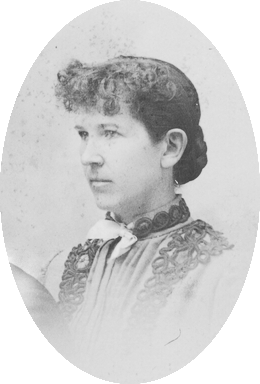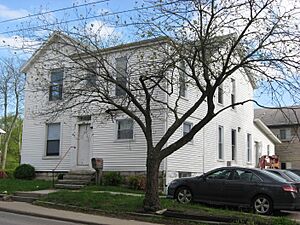Rosa Smith Eigenmann facts for kids
Quick facts for kids
Rosa Smith Eigenmann
|
|
|---|---|

Portrait photograph of Rosa Eigenmann, 1889.
|
|
| Born | October 7, 1858 |
| Died | January 12, 1947 (aged 88) |
| Nationality | American |
| Scientific career | |
| Fields | |
Rosa Smith Eigenmann (born October 7, 1858 – died January 12, 1947) was an American scientist who studied fish, known as an ichthyologist. She was also a writer, editor, and worked as a curator at the California Academy of Sciences. She was the first librarian for the San Diego Society of Natural History. Many people consider her the first woman ichthyologist in the United States.
Rosa Eigenmann was also the first woman to become president of the Indiana University chapter of Sigma Xi. This is a special science society that honors smart scientists. She wrote twelve science papers by herself between 1880 and 1893. She also worked with her husband, Carl H. Eigenmann, on twenty-five more papers. Together, they discovered and described about 150 different kinds of fish!
Contents
Early Life and Education

Rosa Smith was born on October 7, 1858, in Monmouth, Illinois. She was the youngest of nine children. Her parents moved to California in 1876 because they wanted a warmer place for their family's health. They settled in San Diego.
Rosa finished her high school education at the Point Loma Seminary in San Diego. She also took a short business course in San Francisco. She was one of only two women in that class. The other woman was Kate Sessions, who later became famous for her work with plants in San Diego.
Discovering a Love for Nature
Rosa always loved natural history. She started by watching and collecting birds and animals in California. In 1878, she joined the San Diego Society of Natural History. She became the first woman to be a full member of the Society in 1879. She also worked as the Society's librarian and secretary for several years.
Studying Fish at Indiana University
In 1879, Rosa met David Starr Jordan. He was a famous fish scientist from Indiana University in Bloomington, Indiana. He visited San Diego and was very impressed by Rosa. She had just found a new type of fish called the blind goby. This fish lived in caves under Point Loma Peninsula.
Mr. Jordan encouraged Rosa to study zoology (the study of animals) at Indiana University. Rosa accepted his offer. In the summer of 1880, she traveled around Europe with Mr. Jordan and his students. After returning to the United States, she studied at Indiana University for two years. However, she had to go back to San Diego in 1882 because someone in her family became sick. She left without finishing her college degree.
Marriage and Family Life
Rosa met Carl H. Eigenmann at Indiana University. He was a scientist from Germany who was also studying fish. They wrote letters to each other while Rosa was in San Diego. Carl also traveled to California, and they got married at Rosa's home on August 20, 1887.
Rosa and Carl had five children. Raising their children took up most of Rosa's time. This meant she couldn't do as much of her own science research after 1893. However, she still helped her husband by editing his science papers. Three of their children grew up to have professional careers.
A Career in Ichthyology
Around 1879, Rosa discovered the blind goby fish living in underwater caves near San Diego's Point Loma Peninsula. This important discovery led her to get more training in science at Indiana University. It also started her career as a fish scientist.
Early Publications
Rosa published her first science papers in 1880. One was about a fish called Cremnobates and was printed in a museum's science book. Another was a list of fish found in San Diego, which she gave to the San Diego Society of Natural History. The American Museum of Natural History also published some of her articles.
After returning to San Diego in 1882, she focused on writing detailed descriptions of the blind goby and other fish. By the time she was twenty-eight, many of her papers were published. The Smithsonian Institution even asked her to collect a type of fish called surf perch from the San Diego area. Rosa also worked as a journalist for a newspaper called the San Diego Union. She might have been the first woman reporter there!
Collaborating with Her Husband
After Rosa married Carl Eigenmann in 1887, they went to Harvard University. There, they studied collections of South American fish. They also spent time at a U.S. Fish Commission station in Woods Hole, Massachusetts. Their first joint paper was published in 1888. It was about freshwater fish from South America. Rosa also studied a type of plant called cryptogamic botany at Harvard.
In 1889, the Eigenmanns returned to California. They set up a science station in San Diego and kept studying fish. They also worked as curators at the California Academy of Sciences. Later, in 1891, Carl became a professor at Indiana University, and the family moved back to Bloomington, Indiana. Carl later became the head of the zoology department and the first Dean of the Graduate School.
Rosa wrote twelve science papers by herself between 1880 and 1893. She also wrote twenty-five more papers with her husband. Their work on fish from South America and western North America was very important. Their names, "Eigenmann and Eigenmann," became well-known among fish scientists.
Rosa believed that women in science did not get enough credit. She said in 1891 that women's work in science should be judged by the same standards as men's work. It shouldn't just be "well done for a woman."
Later Years
Rosa Eigenmann's last paper with her husband was published in 1893. After that, she stopped doing active research to take care of her family. However, she continued to edit her husband's papers. These papers were about fish from the Pacific Coast, blind cave animals, and South American freshwater fish. In 1893, she also gave a speech at the Smithsonian Museum about women in science. This speech was later published. She also served as president of The National Science Club for Women in 1895.
Carl Eigenmann's health became weak after his trips to Chile in 1918. In 1926, the Eigenmanns moved back to San Diego. Carl had a stroke a year later and passed away on April 24, 1927. Rosa Eigenmann continued to live in the San Diego area, but she no longer did science research.
Death and Legacy
Rosa Smith Eigenmann died on January 12, 1947, in San Diego, California. She was buried in San Diego's Greenwood Memorial Park cemetery.
Her former professor, David Starr Jordan, said that Rosa and her husband discovered 35 new groups of fish. Others say they described almost 150 different kinds of fish. Rosa was also the first woman to be president of the Indiana University chapter of Sigma Xi, a special science society.
Images for kids
-
Eigenmann's former home in Bloomington, Indiana
See also
 In Spanish: Rosa Smith Eigenmann para niños
In Spanish: Rosa Smith Eigenmann para niños



